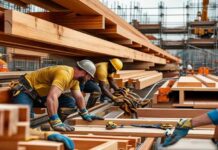Planning a construction project? Whether you’re involved in new construction or a renovation, understanding asbestos safety is crucial. Asbestos, a toxic natural mineral, was widely used in building materials throughout the 20th century.
Though its use has significantly declined, it still poses serious health risks, especially in older buildings. If your project involves any structures built before the 1980s, there’s a good chance that asbestos could be present.
Why Asbestos Is a Concern in Construction
Asbestos was once prized for its fire-resistant and insulating properties. It was used in a wide range of building materials, including insulation, roofing, flooring, and even in certain appliances.
According to the Mesothelioma attorneys in Illinois at Bailey Glasser, when asbestos-containing materials are disturbed during construction, the fibers can become airborne and, when inhaled, can lead to severe health issues, such as mesothelioma, lung cancer, and asbestosis.
Pre-Construction Planning & Assessing Asbestos Risk
Before breaking ground or starting any renovation, it’s vital to assess the asbestos risk on your construction site. Here’s what you need to do:
- Hire Licensed Asbestos Inspectors: Have your site inspected by licensed asbestos professionals. They can identify the presence of asbestos-containing materials (ACMs) and determine if they pose a risk.
- Conduct a Hazardous Materials Survey: This survey will identify all hazardous materials, including asbestos, ensuring that you have a clear understanding of what needs to be handled with care during your project.
- Create an Asbestos Management Plan: If asbestos is found, develop a comprehensive plan that outlines how it will be managed or removed safely.
Common Areas Where Asbestos May Be Found in Construction
Asbestos can be present in many areas of a building, especially older structures. During a construction project, be mindful of these common asbestos-containing materials:
- Insulation: Often found in HVAC ducts, pipes, and attic spaces.
- Roofing Materials: Corrugated roofing, shingles, and even some types of roof tiles.
- Flooring: Vinyl floor tiles, linoleum, and adhesive products.
- Wall Cladding: Exterior and interior wall materials may contain asbestos, especially in older buildings.
- Cement Products: Asbestos-cement boards, pipes, and corrugated sheets.
- Fireproofing Materials: Used in structural steel, fire doors, and other fire-resistant applications.
What to Do if You’re at Risk of Asbestos Exposure
If your construction project involves disturbing asbestos-containing materials, you must take appropriate precautions to protect yourself and your crew:
- Use Personal Protective Equipment (PPE): Ensure that all workers are equipped with PPE, including respirators, disposable coveralls, gloves, and goggles.
- Implement Safe Work Practices: Wet methods, encapsulation, and proper containment can minimize the release of asbestos fibers during construction activities.
- Decontaminate Properly: Establish decontamination procedures for workers and equipment to prevent asbestos fibers from spreading beyond the worksite.
Legal Implications & Complying with Asbestos Regulations
Violating asbestos regulations during a construction project can have severe consequences. In the United States, the Environmental Protection Agency (EPA) enforces strict guidelines regarding the handling and disposal of asbestos. Failing to comply with these regulations can result in:
- Civil Penalties: Fines of up to $25,000 per violation.
- Criminal Charges: Depending on the severity of the violation, criminal charges and imprisonment may be imposed.
- Project Delays: Non-compliance can lead to costly project delays and additional expenses for remediation.
Prioritize Safety and Compliance in Construction Projects
When planning a construction project, especially involving older structures, prioritizing asbestos safety is essential.
By conducting thorough inspections, following proper safety protocols, and adhering to legal requirements, you can ensure a safe and successful project.
If asbestos is identified, always consult with experts who can safely manage or remove the material, protecting both workers and future occupants of the building.





























